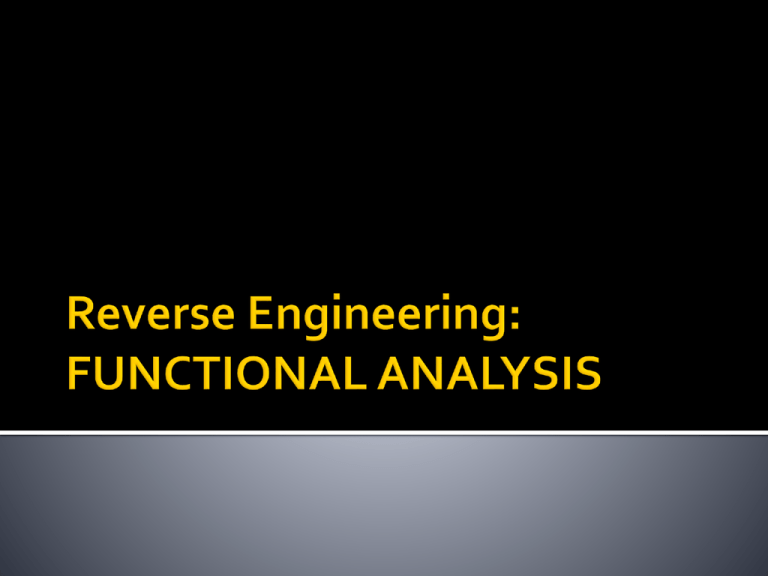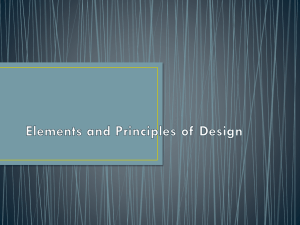Reverse Engineering and Functional Analysis
advertisement

After a product has been selected, a nondestructive Functional Analysis is performed. The product’s purpose is identified. Observations are made to determine how the product functions. These observations are recorded in detail. The system’s inputs and outputs are identified. A theory of operations is developed and recorded. A theory of operation is a description of how the product works and how it is used. Prepare a concise “theory of operations” (black box) that describes how you think your product functions . You will contrast this to what you discover after you disassemble your product. NOTE: you can prepare this a table in MS Word as part of your board presentation. An example: Theory of Operation for a fish finder. What is the product? How does it work (your theory)? What does it do (purpose)? How is it used? What are the major parts? Simple Machines? Source: Airmar technology. (2012, March 28). Retrieved from http://www.airmartechnology.com/uploads/installguide/Theory_of_ Operations.pdf Inputs Black Box Output Product Function It is a non-destructive method of analysis used to identify the sequential operations of a product or system and identify the inputs and outputs of those systems. A black box systems model is used to identify what goes into and out of the product in order to make it work as a system. The black box is a model used to represent the product’s internal components or processes, which may be unknown at this point. Describe the expected purpose of the product. The purpose of a toothbrush is to clean teeth and gums to prevent tooth and gum decay. Water and a cleaning paste are also used in with the brush. Inputs Black Box Output Product Function • Hand motion • Energy • Toothpaste • Water • • • • Batteries Motor Switch Circuit board • • • • Sound Heat Waste Clean teeth and gums The engineer makes an annotated sketch of the product and labels all of the visible components. This information is used to write up a detailed analysis of the object’s sequential operation, or function. 1. 2. 3. 4. 5. 6. Describe the product and its purpose or primary function. Include manufacturer or brand name, if visible. Sketch an isometric pictorial of the product in your engineer’s notebook (both students do their own), and label the individual components. Describe and label the visible components. If you are not sure what a particular component is called, make up a descriptive label. Scan this for use later. Create a “black box systems model” and identify the system inputs and outputs. Label the black box. Black box: Make an educated guess about the product’s function that you cannot identify, because the mechanical components are hidden from plain view. Your “theory of operation” must include both the known (what you can see) and the unknown (what you can guess). Describe which simple machines are used and how they help make the product perform its primary function. This documentation should be in MS-Word and will become part of your technical report. Until then, you must present it as a PPT slide with illustrations. Machines consist of elements, such as wheels and axles, that work together (inputs) to transmit force and produce work (output). No matter how complex, all machines are based on one or more simple machines that change the direction or magnitude of an applied force. This change in force is referred to as “mechanical advantage.” Explore types of levers by clicking Class 1 Class 2 Class 3 Wheel and axle Pulley Lever Inclined plane Wedge Screw You will be expected to identify the simple machines in your product in your analysis. Work indicates that a force is exerted and is moving something Simple machines make work easier Microsoft Office Clipart Microsoft Office Clipart Microsoft Office Clipart © iStockphoto Work is the transfer of energy from one system to another Mechanical work is the product of the magnitude of force in the direction of displacement and the distance through which a body moves Displacement Two connected circular objects of different diameters Microsoft Office Clipart Microsoft Office Clipart Microsoft Office Clipart Microsoft Office Clipart Microsoft Office Clipart Microsoft Office Clipart Gear Wheel with teeth Teeth of one gear push against teeth of another gear Microsoft Office Clipart Microsoft Office Clipart Microsoft Office Clipart Microsoft Office Clipart Microsoft Office Clipart A wheel (and axle) with a rope running over it Microsoft Office Clipart Microsoft Office Clipart Microsoft Office Clipart Microsoft Office Clipart Microsoft Office Clipart A pulley can change the direction of force Multiple pulleys in combination can reduce the effort force to move an object 10 lb 10 lb 80 lb 10 lb 10 lb A bar that is free to pivot around a fixed point Microsoft Office Clipart Microsoft Office Clipart Microsoft Office Clipart Three components Resistance Force Effort Force Fulcrum Resistance Effort Fulcrum Three types Levers Have a Lot of Class. (n.d.). Retrieved from City Tech: http://citytechnology.org/stuff-thatworks/levers-have-a-lot-of-class First Class ▪ Fulcrum between effort and resistance forces ▪ Effort and resistance forces in same direction Effort Resistance Three types Levers Have a Lot of Class. (n.d.). Retrieved from City Tech: http://citytechnology.org/stuff-thatworks/levers-have-a-lot-of-class Second Class ▪ Resistance force between fulcrum and effort force ▪ Effort and resistance forces in opposing directions Resistance Effort Three types Levers Have a Lot of Class. (n.d.). Retrieved from City Tech: http://citytechnology.org/stuff-thatworks/levers-have-a-lot-of-class Third Class ▪ Effort force between fulcrum and resistance force ▪ Effort and resistance forces in opposing directions Resistance Effort Slanted surface used to raise an object Microsoft Office Clipart © iStockphoto © iStockphoto Microsoft Office Clipart Wedge Screw Images from Microsoft Office Clipart Inclined plane that moves A triangle shape with a sharp point Can split, cut, tighten, or hold things together Microsoft Office Clipart Microsoft Office Clipart Microsoft Office Clipart Microsoft Office Clipart Microsoft Office Clipart Inclined plane wrapped around a shaft Used to fasten things together or move things © iStockphoto Worm gear © iStockphoto © iStockphoto Corkscrew conveyor © iStockphoto Parking garage ramp Microsoft, Inc. (2008). Clip art. Retrieved from http://office. microsoft.com/en-us/clipart/default.aspx Wikipedia. Retrieved from http://en.wikipedia.org iStockphoto. Retrieved from http://www.istockphoto.com/index.php






